Are you an intermediate reptile keeper who is looking for your next challenge? If so, the carpet python may just be the next species for your collection.
Carpet pythons are amazing snakes that are often misunderstood, even by the so-called experts. Often portrayed as a snake with an attitude and a nippy disposition, carpet pythons generally become used to handling and can even be docile.
Additionally, carpet pythons are intelligent and curious snakes that are often beautifully colored.
Carpet pythons can be a rewarding species to own if you understand this species and its needs. The following guide contains important information to help you determine if the carpet python is the next snake for you.
Species Summary
Carpet pythons are a semi-arboreal species and belong to the genus Morelia.
They are found mainly in Australia, the island of New Guinea, and the Solomon Islands.
There are seven basic subspecies of carpet pythons:
- Jungle carpet python (Morelia spilota cheynei)
- Southern carpet python (Morelia spilota imbricate)
- Coastal carpet python (Morelia spilota mcdowelli)
- Inland carpet python (Morelia spilota metcalfei)
- Diamond python (Morelia spilota spilota)
- Irian Jaya carpet python (Morelia spilota variegata)
- Papuan carpet python (Morelia spilota harrisoni)
Also, there are numerous morphs as a result of the selective breeding of this species.
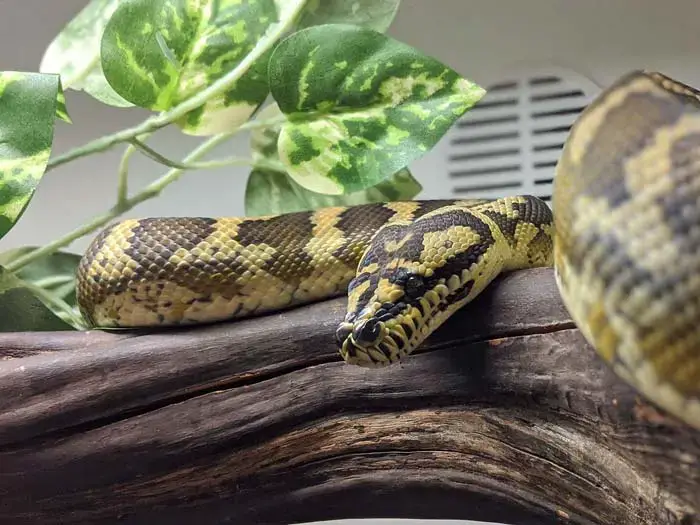
Appearance & Colors
Because of their semi-arboreal nature, carpet pythons have a slender built. Their colors are wide-ranging, depending on the subspecies. The jungle carpet python has a striking appearance with its black and yellow markings.
The coastal carpet python is brownish with yellow stripes, while Irian Jayas is brownish with tan colored markings.
Diamond carpet pythons are black colored with yellow or white dots.
In fact, carpet pythons got their name because of their amazing array of colors and patterns that resemble the woven carpets of the Middle East
Carpet Python Size
Just as with color, the size of adult carpet pythons is dependent upon the subspecies.
Smaller species like the Irian Jaya python reach about five feet upon maturity. In comparison, mature coastal carpet pythons can approach nine feet.
In many species of carpet pythons, the male and female are of similar size. However, female diamond and coastal carpet pythons are often larger than the males.
Newly hatched carpet pythons, regardless of the species, are about the size of a pencil.
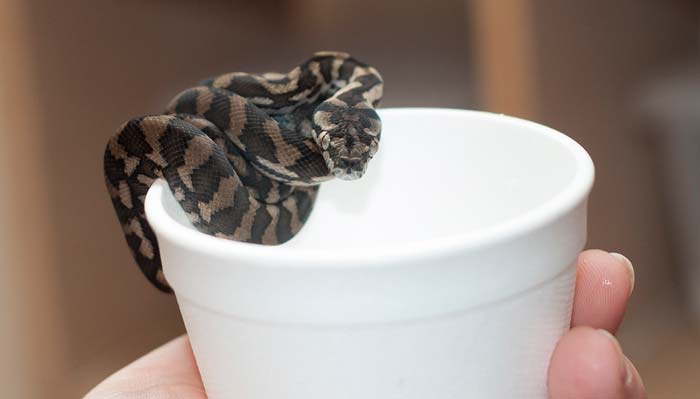
Life Span
If you are interested in getting a carpet python, you need to think long term! Carpet pythons are long-lived and commonly live over 20 years in captivity.
Carpet Python Care
At the beginning of this article, it was mentioned that carpet pythons are for intermediate reptile collectors. This is because these medium-sized pythons thrive when their health and wellness are given priority by their keepers.
Fortunately, there is a lot of information on caring for carpet pythons because they are commonly captive bred.
However, information is only useful if it is employed. With carpet pythons, their enclosure, temperature, and humidity all matter! We will go into more detail on carpet python care in the following sections.
Enclosure Size and Dimensions

Intermediate and expert reptile collectors understand that the times have changed! It used to be appropriate to use an aquarium as an enclosure for most reptiles.
There have been major advances in understanding the needs of our reptile charges. With that, there also have been advances in the way we house our reptiles.
Carpet pythons provide a great example of how important it is to understand the reptile species’ needs before we make any decisions on how to house them.
The enclosure for carpet pythons should provide the following:
- Maintaining humidity
- Provide a temperature gradient
- Provide unobstructed viewing of the snake
- Abundant room for the snake to move around and climb
- Offer easy access for cleaning
- Provide the snake with a sense of security
Reptile collectors who are experienced in caring for carpet pythons favor enclosures that are made of glass, PVC, plastic, or polyethylene.
Such enclosures will have a solid and opaque top, bottom, and sides. The cage door will be located in front and be made of glass or acrylic plastic.
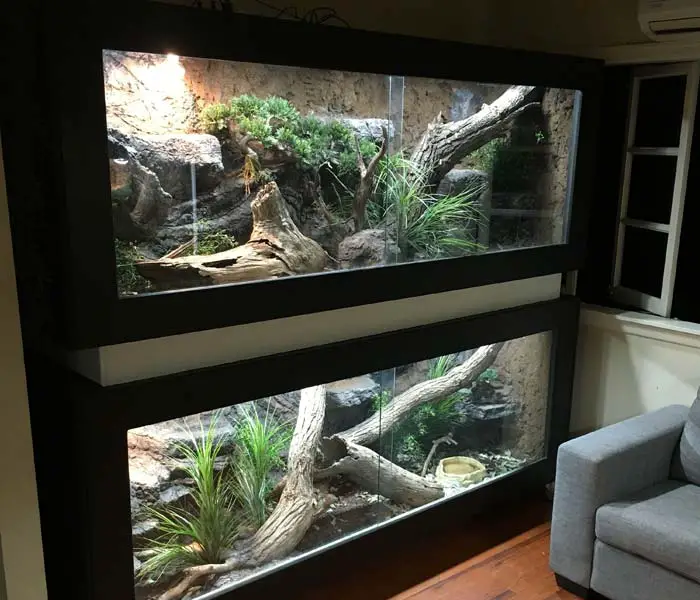
Aquariums have a top entry, which can stress out carpet pythons and other reptiles.
Baby carpet pythons spend a lot of time trying to avoid being eaten by a predator, which is why they are often nippy or defensive.
Predators who hunt baby carpet pythons often do so by attacking from above.
If you have a baby or juvenile carpet python in an enclosure that has a top entry, what do you think it will be thinking when you reach your hand into the cage from above? You guessed it! You are seen as a threat! By having an enclosure with front entry, you will create less stress for your carpet python.
Unlike aquariums, which are made of all glass, the opaque top and sides of PVC enclosures will provide your carpet python with a sense of security.
Being made of glass, aquariums absorb heat, which will make having a temperature gradient for your carpet python more difficult.
An enclosure made of PVC, or similar material, will make it easier for you to maintain a temperature gradient (see Temperature & Lighting for more details).
The enclosure dimensions should be such that the sum of the enclosure’s length and width should be greater than the length of the snake.
Additionally, carpet pythons are semi-arboreal, so it is important to provide enough height to the enclosure so that they can climb.
REPTI ZOO Large Glass Reptile Terrarium
The following are recommendations for enclosure dimensions based on age:
- Newborn Carpet Pythons: The enclosure can be as small as a 15-gallon container. (You can check Exo Terra All Glass Terrarium Kit)
- Young Adult Carpet Pythons (Up to a year old): At least 36 by 18 inches (Exo Terra High Glass Terrarium or REPTIZOO Large Glass Reptile Terrarium would be appropriate products for this age group.)
- Adult Carpet Pythons: The enclosure should be at a minimum 4′ by 2′.
As with all snakes, carpet pythons are master escape artists. It is important to make sure that the enclosure is secure and that all doors are locked or have a clip to secure them.
Habitat Setup

The enclosure for your carpet python should be equipped with the following:
Climbing Objects: As carpet pythons are semi-arboreal, it is recommended that you provide them with branches, a shelf, or other cage furniture that will allow them to get off the ground.
Hiding Places: While having an opaque top and sides is important for giving your carpet python a sense of security, it is not enough! Also, provide a hide box or other cage furniture that will allow your carpet python to hide and enjoy a sense of privacy.
When selecting a hide box, you want one that is large enough to accommodate your snake but small enough that your carpet python is able to touch all sides of the hide box. Such a hide box will give your snake a greater sense of security.
Substrate: Carpet pythons have been successfully raised on a variety of cage substrates. The following is a list:
- Newspaper (Note: Remove wet newspaper from the enclosure to avoid skin infections).
- Cypress mulch: (Commercial products include Zoo Med’s Forest Floor 100% Natural Cypress Mulch Reptile Bedding).
- Pinewood mulch
- Laboratory grade bleached hardwood pulp
- Avoid using pine, walnut, or cedar bedding. These substrates have oils and a strong smell that can irritate your snake.
- Eliminate the dust from wood shavings before putting them in the enclosure. Dust from shavings can be irritating to your snake and dehydrate them as well.
Regardless of the substrate you use, it is important to spot clean the substrate daily. Also, the substrate should be changed completely every six to eight weeks.
Temperature & Lighting
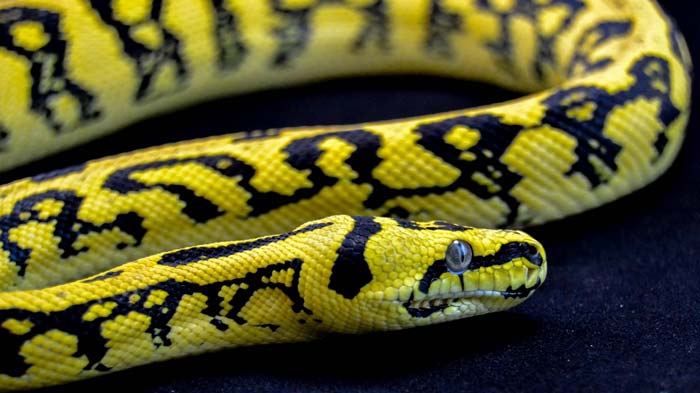
In previous sections of this care guide, the term “temperature gradient” was mentioned. It is now time to explore this term more fully.
Temperature gradient means a range of temperatures. What does this mean for carpet pythons and other herps that you may have? It means a healthier and happier animal!
The idea is that your carpet python should be able to find a place in its enclosure where its preferred temperature is available.
Ideally, part of the enclose should offer a temperature of 90 degrees Fahrenheit (32 degrees Celsius) for the high. Another part of the enclosure should have a temperature of 80 degrees Fahrenheit (26 degrees Celsius).
When the enclosure is set up in this way, your carpet python can find a place where the temperature suits it best. In the evenings, the temperature can drop into the 70’s Fahrenheit (21 degrees Celsius). Offering this kind of temperature gradient will benefit your carpet python health-wise as you duplicate the wild’s natural conditions.
To heat the enclosure, there are a number of available products. These include ceramic heat emitters or radiant heat panels that are attached to the enclosure.
The company Fluker’s makes a ceramic reptile heat emitter. Having said this, a word of caution is needed.
Ceramic heat emitters can lower the humidity of the enclosure, which is important to carpet pythons. For this reason, the use of radiant heat panels is recommended, especially for a larger enclosure.
For smaller enclosures, the use of flex watt tape or heating pads can provide the needed heat source.
Zoo Med Reptitherm Undertank Heater
Both Zoo Med and Exo Terra make heating pads that can meet your need. Hot rocks should be avoided as they often heat up unevenly and can cause burns
Regardless of your choice of heating products, it is recommended that you have the enclosure temperature controlled through the use of a thermostat. You may wish to check out BN-LINK Digital Heat Mat Thermostat Controller for this purpose.
As for lighting, there is no consensus among advanced keepers on the lighting requirements for carpet pythons.
To be on the safe side, it would not hurt to offer both LED and UV lighting, especially if your carpet python does not have access to natural sunlight.
Offering full-spectrum lighting can only enhance the wellbeing of your carpet python (especially for Diamond Python), but as we mentioned before, it’s not necessary.
Zoo Med ReptiSun 5.0 UVB provide for your snake’s full-spectrum light needs. Such products are often used by breeders so that they can adjust to the changes of seasonal light.
For basking lights, both Exo Terra and Fluker’s make ceramic domes to house the lights. These ceramic domes are also equipped with an on/off switch.
Finally, get a good quality thermometer so that you can check the temperature and ensure that it is where it needs to be. We recommend Zoo Med Labs Digital Hygrometer and Thermometer.
Humidity
Zoo Med Labs Digital Hygrometer and Thermometer
Carpet pythons do best with a humidity of around 50%. Achieving this level of humidity is not difficult.
A simple trick used by many professional keepers is to have a large water bowl in the enclosure.
Besides providing humidity, a large water bowl will offer your carpet python a place to soak when it wants to.
Besides providing a large water bowl, you can also provide daily misting to help keep the humidity level up.
Allow the enclosure to dry between misting. Bacterial growth can occur when misting is overdone.
Water
Besides raising the humidity level, a large water bowl will provide your carpet python with all its drinking needs.
It is recommended that you give the water bowl a good cleaning at least once a week, or whenever your carpet python leaves droppings in it.
Food & Diet
Carpet pythons tend to be good eaters, and thus it is important not to overfeed them. Thawed rats and mice are good food items, depending on the size of the snake.
For snakes that are between hatchling and one-year-old, it is advised to feed once a week.
The food item’s circumference should be no larger than 1½ time the snake’s girth (the largest point of the snake’s body).
For snakes that are two years or older, a good size meal every two weeks will suffice.
Another guideline used by experienced keepers is to feed juvenile pythons 10% of their weight weekly and to feed adults 10% of their weight every 2-3 weeks.
Some carpet pythons that are raised on a diet of mice will have trouble crossing over to a diet of rats.
If you have such a snake, you can entice it to eat rats by thawing a small rat and a mouse in the same ziplock bag. Add a little water to the bag to help the smell of the mouse be taken up by the rat.
Eventually, your snake should start eating rats. It is recommended that you do not handle your carpet python for several hours after it has eaten. Live rats and mice should never be given due to the potential risk to the snake.
Potential Health Issues
The expression “an ounce of prevention is worth a pound of cure” holds true for all captive animals and us!
By following this care guide, you should avoid experiencing most health issues with your snake. Should you have any concerns, it is a good idea to find a local veterinarian who is experienced in treating reptiles.
Having said that, the following are potential health issues for your carpet python:
- Mites: Check your carpet python for mites on a regular basis. Mites can be a significant cause of irritation for your python.
- Dysecdysis: Also known as abnormal shedding, dysecdysis is often caused by inadequate humidity levels. If you see that your carpet python is experiencing an incomplete shed, have the snake bathe in a large container of water and increase the humidity level in the enclosure.
- Respiratory Infection: Respiratory infections are caused by viral or bacterial infections. Common causes of respiratory infections include improper temperature, ventilation, or excess humidity.
The following are health warning signs for your carpet python:
- Lack of appetite
- Spending excessive amounts of time submerged in its water bowl
- Emitting a wheezing sound when breathing
- Discharge, which can be fluid, from their nostrils or mouth.
- Diarrhea
Behavior & Temperament

Earlier in this care sheet, it was stated that carpet pythons should be kept by intermediate collectors.
This means that you should only consider getting a carpet python if you have successfully kept other snake species in the past and are ready for a more challenging snake.
Carpet pythons have the reputation of being nippy and having an attitude. It is important that young snakes are hard-wired to defend themselves from predators, many of which attack from above. As carpet pythons become older, they become more docile.
With patients, you can get to the point where your carpet python will enjoy, if not tolerate, being handled. The following are tips for taming your carpet python:
- Make sure the snake’s enclosure has a front entry as opposed to a top entry.
- Carpet pythons have a strong feeding response. Restricting feeding to inside the enclosure will help prevent your snake from confusing you with food.
- Build trust with your snake by allowing it to get to know you. Take small steps where you demonstrate to your carpet python that you are not a threat. For example, if you reach your hand in the enclosure and see that your snake is becoming defensive, stop or slowly withdraw your hand. Let your snake determine when you should engage with it further or if you should retreat and call it a day!
Handling Them

When handling your carpet python, remember that they are semi-arboreal and that they have a natural defensive attitude to keep them safe from predators. Keeping this in mind, here are some tips for handling your snake:
- Allow your carpet python time to get to know you. Do not attempt to handle it until you have had it for a few days.
- Gradually increase the amount of handling time each day.
- When handling your carpet python, support your snake’s body. In fact, carpet pythons like to perch on branches. Raising your hands overhead and allowing your carpet python to perch above you can have a calming effect on it.
- Avoid touching your carpet python on its head. If your snake does not trust you, it could cause it to react defensively. Avoid any fast movements.
- When handling your carpet python, do not restrain it. Instead, let it move about as you support its body.
- With carpet pythons, you have to learn how to “read” them. While many snake species are easy to read, carpet pythons require time before you can read them.
Conclusion
The major reason why carpet pythons are considered to be an intermediate snake is that they have the qualities that make them a “half-way” snake species. Consider the following:
- Carpet pythons are manageable size snakes and cannot inflict serious injuries on keepers. Yet, they are intelligent and inquisitive snakes. For this reason, you need to be alert when working with them.
- It is not difficult to get captive-born carpet pythons because they are widely bred by breeders. Yet, carpet pythons are less tolerant of husbandry mistakes than other species, such as ball pythons. While a ball python can survive despite errors in husbandry, those same mistakes could cost the life of your carpet python.
- Carpet pythons are not cheap, nor are they overly expensive. The average snake is between $100-300.
For these reasons alone, you can see that keeping carpet pythons involves a real commitment, time, and patience. If you are willing to do so, you will be rewarded with a rich experience in keeping this snake.
Related:

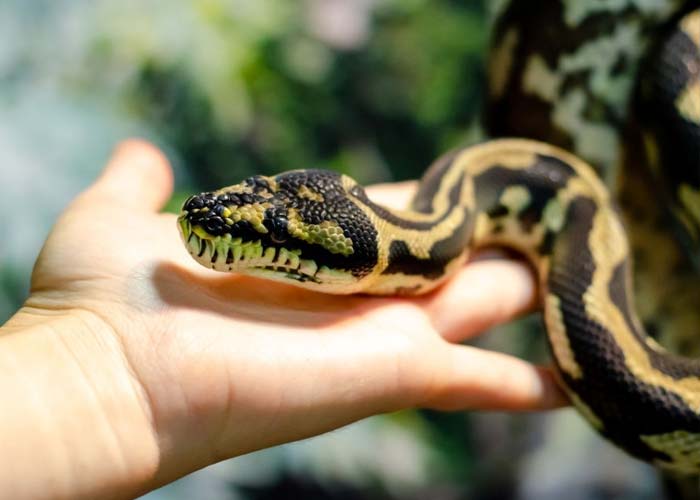





Thanks for taking the time to write this blog I have just bought my first carpetbpythin and I waited until I had my ball python over 2 years to make sure I had most things ironed out and the confidence to know how to tweak issues should they arise, I cant tell you how excited I am for her to get here shes just a hatchling so it will be July before I can get her to travel to me so plenty more time for researching the subject I wanted to know the best size and kind of viv to get as for me I believe the best start you and your snake gets the easier it can be for you to strike a bond where the snake knows you’re not a threat to them, I appreciate the effort thanks very much